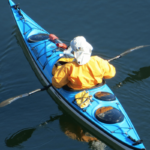Ever wondered why kayaks, those sleek vessels that glide across water, come designed with holes in them? This peculiar feature, often noticed but rarely understood, plays a significant role in the kayak’s functionality and the paddler’s safety. Beyond mere aesthetics or an engineering oversight, these holes serve crucial purposes that enhance the kayaking experience. Dive into the mystery behind this design choice and discover how it impacts your journey on the water. Join us as we unravel the secrets of kayak design.
Understanding Kayak Scupper Holes
Kayaks are ingeniously designed for stability, buoyancy, and safety, with every feature serving a purpose. Among these features, scupper holes hold a unique place. Primarily found in sit-on-top kayaks, these holes are not a design flaw but a clever engineering solution to a common problem. They allow water that splashes onto the kayak to drain out, helping to keep the vessel afloat and the kayaker dry.
Scupper holes are strategically placed at the kayak’s lowest points, where water naturally collects. Their presence ensures that water does not pool on the deck, which can be both uncomfortable and dangerous, potentially leading to instability. By allowing water to flow out, scupper holes play a critical role in the self-bailing mechanism of a kayak. This feature is particularly valuable in choppy waters or during inclement weather, where water ingress is more frequent.
While scupper holes are beneficial, they also have a downside. They can allow cold water to splash up into the kayak, which can be uncomfortable in cooler weather. To address this, many kayakers use scupper plugs to block the holes, effectively stopping water from entering. However, it’s important to remember that the plugs should be removed when conditions warrant, to allow any accumulated water to drain away.
- Design Purpose: Understand the primary function of scupper holes in maintaining a kayak’s buoyancy and stability.
- Location and Function: Learn about the strategic placement of scupper holes and how they contribute to the self-bailing mechanism.
- Weather Conditions: Gain insights into how scupper holes benefit kayakers in different weather conditions and water types.
- Scupper Plugs: Discover the use of scupper plugs for blocking holes in colder conditions and how to use them effectively.
- Maintenance Tips: Explore best practices for maintaining scupper holes to ensure they function properly and extend the lifespan of your kayak.
Integrating scupper holes into the kayak’s design showcases the thoughtful consideration of safety and comfort in watercraft engineering. By understanding the purpose and proper use of scupper holes, kayakers can enhance their on-water experience, ensuring they stay dry and comfortable, regardless of the conditions they face. Whether navigating calm waters or tackling waves, the knowledge of how and why these holes exist contributes to a safer and more enjoyable kayaking adventure.
Enhancing Kayak Drainage and Safety
The presence of holes in kayaks, often a subject of curiosity, plays a crucial role in enhancing the safety and functionality of these vessels. Primarily, these holes serve as a drainage system, allowing water that enters the kayak to exit efficiently, thus preventing the kayak from becoming overly heavy or unstable. This feature is especially vital in sit-on-top kayaks where the paddler’s seating area is exposed to water, from waves or paddling, more directly than in enclosed models.
Moreover, the strategic placement and design of these holes contribute significantly to the safety of the kayaker. In scenarios where the kayak capsizes, the ability of the kayak to drain quickly reduces the risk of it remaining submerged or becoming difficult to recover. This aspect is paramount in ensuring that kayakers can re-enter their boats in open water without assistance, making self-rescue practices more effective. Furthermore, these drainage holes are designed to minimize the loss of speed and maneuverability, ensuring that the kayak remains responsive and easy to control, even in challenging conditions.
Further Insights into Kayak Safety Features
In addition to drainage, modern kayaks incorporate various design elements aimed at enhancing safety. These features range from the materials used in construction, which ensure durability and impact resistance, to ergonomic designs that improve comfort and reduce the risk of injury. For instance, the use of UV-resistant materials helps maintain the integrity of the kayak under prolonged exposure to sunlight, while adjustable footrests and seating support the paddler’s posture during extended periods on the water.
- Drainage systems for removing water
- Material choices for durability and UV protection
- Ergonomic design for comfort and injury prevention
- Adjustable features to accommodate various paddlers
- Safety elements for effective self-rescue capabilities
Impact on Kayak Stability and Speed
The presence of holes in a kayak, often referred to as scupper holes in sit-on-top kayaks, plays a crucial role in both the vessel’s stability and speed. These holes are deliberately designed into the kayak to allow water that splashes onto the deck to drain out quickly, ensuring the kayak remains buoyant and stable in the water. This self-bailing mechanism is particularly beneficial in choppy conditions or when the kayak takes on water from waves or rapids.
Furthermore, the strategic placement and size of these holes are carefully considered to minimize their impact on the kayak’s speed. While one might assume that holes could slow the kayak down by increasing water resistance, their design ensures that the water flows through them with minimal drag. This balance between drainage and drag reduction is essential for maintaining the kayak’s performance, especially in competitive kayaking where speed is paramount. However, it’s important to note that the effect on speed can vary depending on the kayak’s specific design and the water conditions.
In terms of stability, the scupper holes contribute by allowing the kayak to shed excess water, thus preventing it from becoming top-heavy and unstable. This feature is particularly important for beginners who may not have the skill to manually bail water or for those kayaking in conditions where water frequently enters the kayak. By maintaining a lower center of gravity through automatic drainage, kayakers can enjoy a safer and more stable ride.
Additional Insights on Stability and Speed
It’s worth noting that the design and number of scupper holes can vary widely between different models of kayaks. Some are equipped with adjustable plugs, giving paddlers the option to close the holes in calm water conditions to reduce drag further and increase speed. This adaptability allows kayakers to customize their experience based on their environment and needs, highlighting the innovative design considerations that go into modern kayak construction.
Moreover, the impact of scupper holes on a kayak’s stability and speed underscores the importance of selecting a kayak that is well-suited to an individual’s specific paddling conditions and experience level. For instance, a kayak designed for racing on calm waters may have fewer and smaller scupper holes to optimize for speed, whereas a kayak intended for rough water conditions might feature more and larger scupper holes for enhanced stability and safety.
| Kayak Type | Number of Scupper Holes | Optimized For |
|---|---|---|
| Racing Kayak | 2-4 | Speed |
| Recreational Kayak | 4-8 | Stability |
| Fishing Kayak | 6-10 | Stability & Storage |
| Whitewater Kayak | 4-6 | Drainage & Maneuverability |
| Touring Kayak | 2-6 | Speed & Distance Coverage |
The interplay between kayak design, including the presence and characteristics of scupper holes, and its performance in terms of stability and speed is a fascinating aspect of kayak engineering. By understanding the purpose and function of these features, paddlers can make informed decisions about their equipment, leading to a safer and more enjoyable experience on the water.
Scupper Plugs: Pros and Cons
Kayaking enthusiasts often ponder the utility and drawbacks of scupper plugs. These accessories are integral to sit-on-top kayaks, designed with self-bailing mechanisms. The primary function of scupper holes is to allow water that splashes onto the deck to drain away quickly, ensuring the kayak remains buoyant and stable. However, in certain conditions, these openings might let water flow back into the kayak, which is where scupper plugs come into play. By sealing these holes, scupper plugs can significantly reduce or altogether prevent water ingress, offering a drier kayaking experience.
On the upside, the use of scupper plugs enhances comfort during colder weather or in choppy waters, where splashes are more frequent. They contribute to a warmer and drier ride, which is particularly appreciated by those who kayak in cooler climates. Moreover, they can be selectively used in only some of the scupper holes, allowing for customizable water drainage and retention based on specific conditions and personal preferences.
Conversely, the downside to using scupper plugs includes a potential compromise in the kayak’s inherent safety feature—the ability to self-drain. In heavy rain or in waves, a kayak without scupper plugs will naturally expel water, whereas one with the plugs might fill up if water breaches the deck. Additionally, forgetting to remove these plugs when necessary can lead to an unintended accumulation of water inside the kayak, making it heavier and less responsive.
| Aspect | Pros | Cons |
|---|---|---|
| Comfort | Reduces water ingress, leading to a drier experience | Can lead to water accumulation if not managed |
| Safety | Can be used selectively based on conditions | May compromise kayak’s self-draining feature |
| Usability | Improves experience in cold weather | Requires monitoring and management |
| Flexibility | Allows for customizable drainage | Potential for forgetting to remove plugs |
| Weight | Can prevent unnecessary water weight | Improper use can make kayak heavier |
Understanding the pros and cons of scupper plugs is crucial for kayakers who wish to optimize their experience on the water. Whether to use these plugs comes down to a matter of personal preference, kayaking environment, and the specific conditions expected during the outing. It is advisable for kayakers to experiment with and without scupper plugs in various conditions to grasp their benefits and limitations fully. This knowledge enables kayakers to make informed decisions, ensuring both safety and enjoyment in their aquatic adventures.
Maintenance Tips for Kayak Holes
Maintaining the holes in a kayak, often referred to as scupper holes in sit-on-top kayaks, is crucial for both the longevity of your kayak and your safety on the water. These holes are designed to drain water that splashes into the kayak, but they also require regular inspection and care. Firstly, it’s essential to clean these holes regularly to prevent clogging from sand, debris, or small pebbles, which can impede water drainage. A simple rinse after each use can go a long way in maintaining these drainage paths.
Moreover, inspecting the edges of the holes for any cracks or damage is vital. Even minor damage can lead to larger structural issues over time. If any damage is found, repairing it promptly with a kayak repair kit or seeking professional repair services is recommended. Additionally, applying a UV protectant spray can help prevent the degradation of the kayak material around the holes, especially for those crafted from plastic or composite materials. This preventative measure can significantly extend the durability of your kayak.
Lastly, for kayaks used in saltwater, a thorough freshwater rinse is indispensable. Salt can corrode and damage the kayak, including the areas around the scupper holes. Ensuring that these holes are clear and the surrounding areas are free from salt residue will protect your kayak from premature wear and tear.
Enhancing Kayak Hole Durability
Proactive Measures for Kayak Hole Maintenance
Taking proactive steps towards maintaining the scupper holes of your kayak not only ensures a safer kayaking experience but also prolongs the functional life of your kayak. Regular maintenance, coupled with periodic checks for wear and tear, forms the cornerstone of kayak care.
| Maintenance Task | Frequency | Benefits |
|---|---|---|
| Cleaning of Holes | After every use | Prevents clogging and ensures efficient water drainage |
| Inspection for Damage | Monthly | Identifies potential issues early to prevent major repairs |
| Application of UV Protectant | Every 3-6 months | Protects against material degradation from sun exposure |
| Saltwater Rinse | After every saltwater use | Prevents corrosion and material damage |
| Professional Inspection | Annually | Ensures structural integrity and safety |
In conclusion, regular maintenance of kayak holes is a vital aspect of kayak care that should not be overlooked. Simple steps such as cleaning, inspecting, and protecting these drainage pathways can significantly impact the longevity and performance of your kayak. By adopting a proactive approach to maintenance, kayakers can enjoy many years of safe and enjoyable adventures on the water.
I’m Adam Reynolds, a dedicated sports writer with a passion for both competitive gaming and betting. In my mid-thirties, I dive deep into the world of sports, providing insightful analyses and strategies to help readers make informed betting decisions. My experience spans various sporting events, where I blend my love for the game with a keen eye for betting trends. Whether I’m dissecting game tactics or offering betting tips, I aim to deliver content that is both engaging and practical. Join me as we explore the exciting intersection of sports and betting together.





